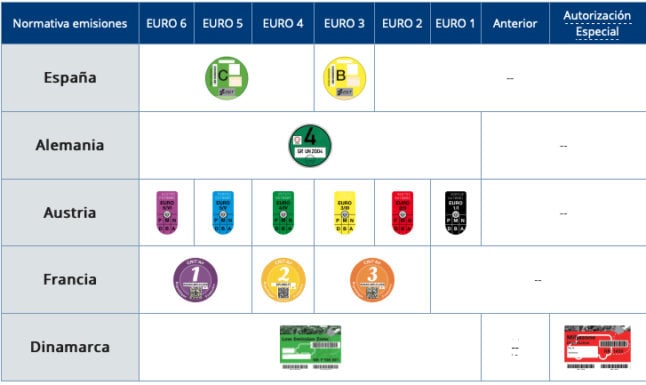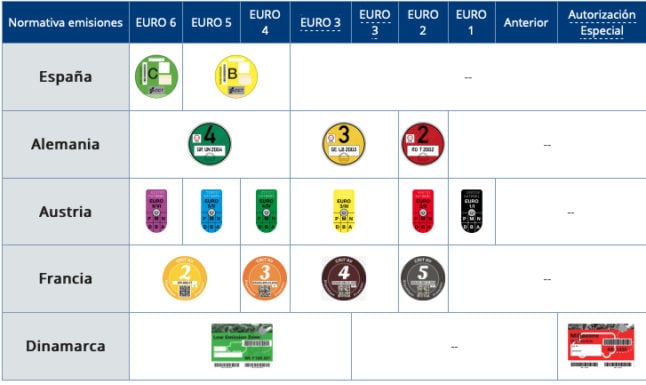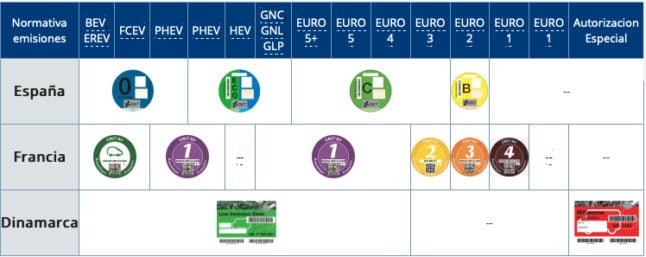As part of the Spanish government’s climate change and energy transition legislation, a series of low-emission zones (Zonas de Bajas Emisiones, ZBE) were introduced across the country from January 1st 2023.
- READ ALSO: Driving in Spain: What changes in 2023?
- READ ALSO: Spain ends fuel discount for almost all drivers
In order to help enforce these new ZBEs, the Spanish government are rolling out emissions stickers to identify which type of car you have, its emission status, and to help fine those drivers who disregard the new rules of the road.
You can find out more information about the different types of stickers and how they will affect drivers, which The Local covered here.
READ ALSO: GUIDE: How to get an emissions sticker for your car in Spain
Understandably, as so many millions of people visit Spain on holiday every year, many are wondering how all this will affect them especially if they drive in Spain in a foreign registered car.
Do I have to buy a Spanish emissions sticker for my internationally registered car?
No, well at least not the emissions-specific stickers Spanish drivers will use, anyway. But you may have to purchase something depending on where you are from and where you are going, as we explain below.
In fact, the DGT do not even release or allow Spanish emissions stickers on foreign cars.
READ ALSO: The new road signs drivers in Spain need to know in 2023
-
Motorcycles and mopeds (category L) classified as Euro 2 or higher (usually registered after 2003).
-
Passenger cars (M1) classified as electric, Euro 3 gasoline (usually registered after 2000) or higher or Euro 4 diesel or higher (usually registered after 2005).
-
Trucks (N2, N3), buses and coaches (M2, M3): electric, diesel Euro 4 or higher (usually registered after 2005).
Others however, especially older cars, won’t meet those requirements and have to apply for day permits, and can use up to 10 one-day authorisations throughout the year.
You can find all the information you need about registering, applying and paying for the day permits here.
Registration is €5 and it’s €2 per extra day authorisation, so we can use those figures as a ball-park estimate for what other ZBE passes around Spain might be.
You can find information on registering your car in the Madrid ZBE here.
Though most areas are still finalising the details of their ZBEs, it’s likely other cities will use similar systems and you’ll have to register you car and pay for some kind of daily permit to use the low-emission zones.
What happens if I don’t?
If you drive into a ZBE without authorisation (and are caught), you’ll be fined €200. This is the flat-rate fine for Spaniards and foreigners, established in Spain’s Traffic Law reforms back in March 2022.
What if I live in a country with its own vehicle emissions categories?
If you live in a country like France and already have an equivalent sticker then you won’t have to buy a Spanish emissions sticker. In fact, you likely won’t have to pay anything at all, depending on your car.
There are several other countries in Europe that have their own system of environmental car stickers. These are Germany, Austria, Denmark, and France.
If you have a car registered in one of these countries and want to drive in Spain, specifically in one of the newly established ZBEs, or in certain parts of Madrid and Barcelona, where they’ve been established for some time, you’ll be able to drive with the sticker from your own country but will need to understand what they entitle you to do and where they entitle you to go.
What their equivalent in Spain would be, in other words, as this could potentially affect where you’re allowed to drive.
Fortunately, the DGT does have some guidance on this, which you can find here.
Petrol cars
According to the DGT website, if you have a petrol car or small van the sticker equivalencies are as follows.

Diesel cars
If you have a diesel car or small van:

Motorbikes and other two-wheel vehicles


It is worth noting, however, that despite the new rules officially being introduced to start 2023, they are not being actively enforced yet. In fact, many cities have already suggested that it could take some time, such as Zaragoza, which has said it will take months to begin applying it, and Valencia, where the deadline to finalise the rules and fines has been vaguely defined as sometime “in the course of 2023.”
The only places implanting the rules (and fines) to start of 2023 are Madrid, Barcelona, Pontevedra, in Galicia, and Zaragoza.



 Please whitelist us to continue reading.
Please whitelist us to continue reading.
Member comments